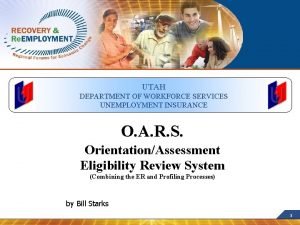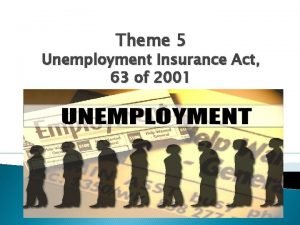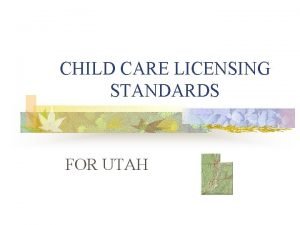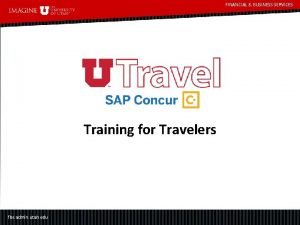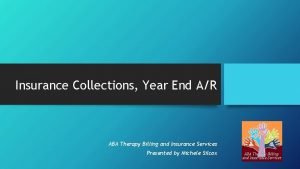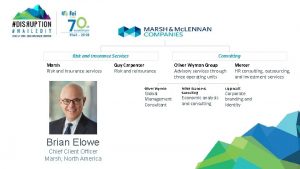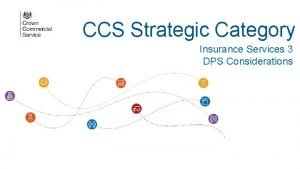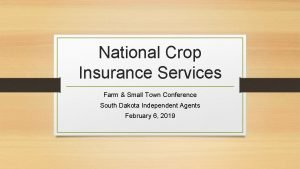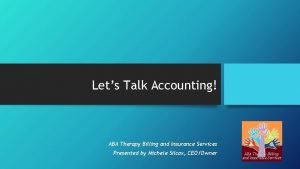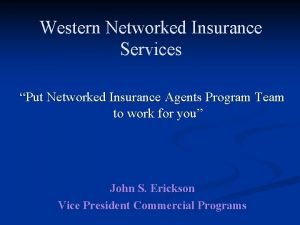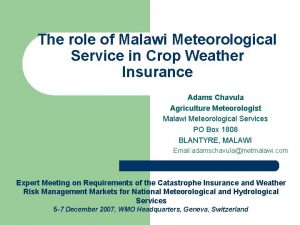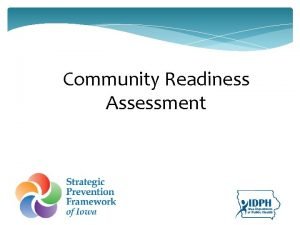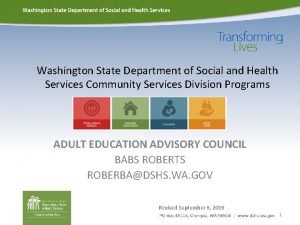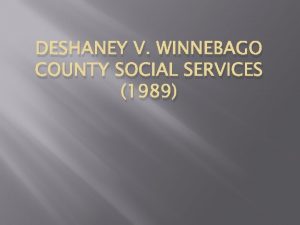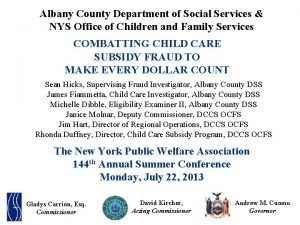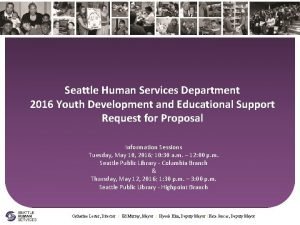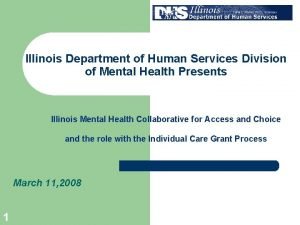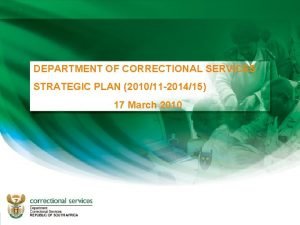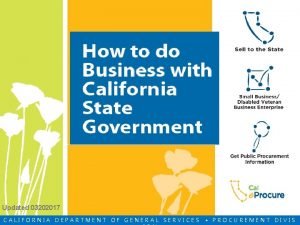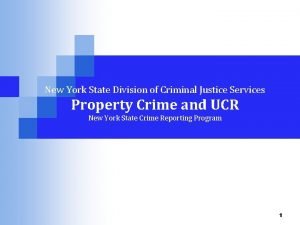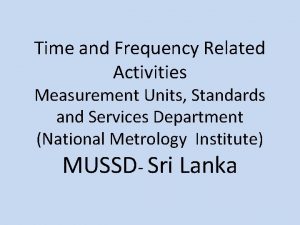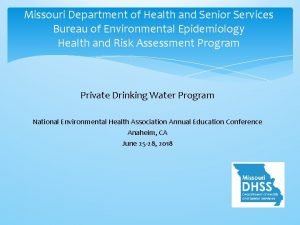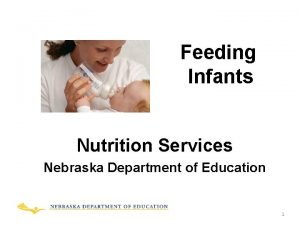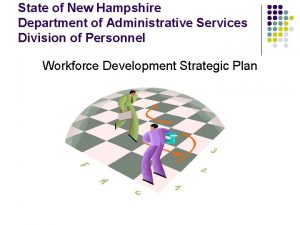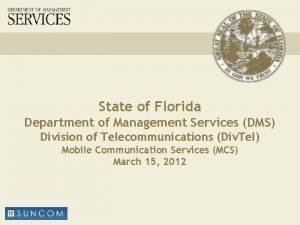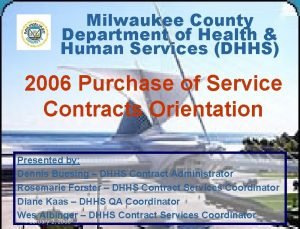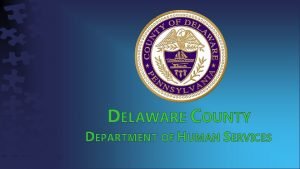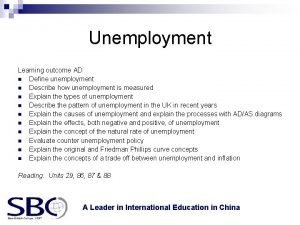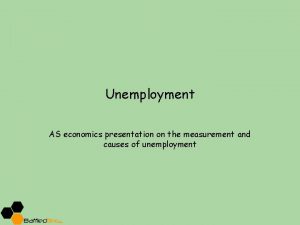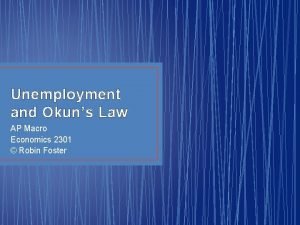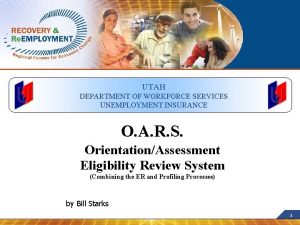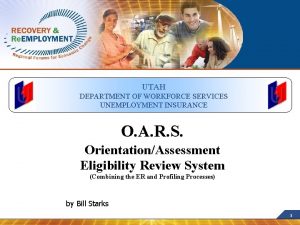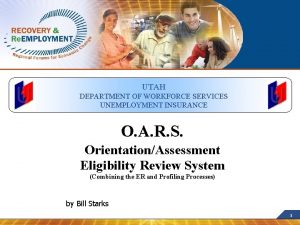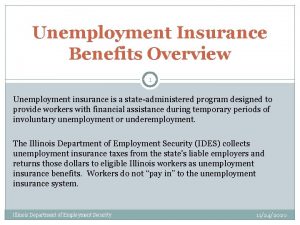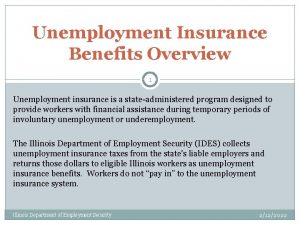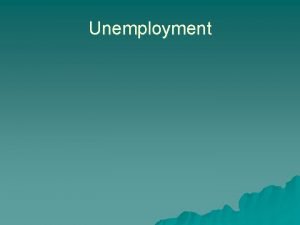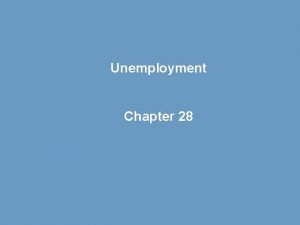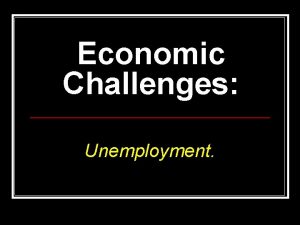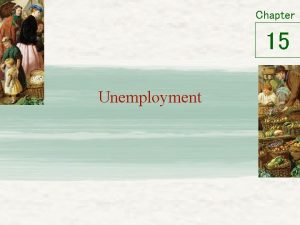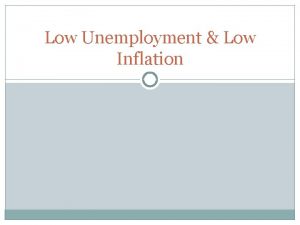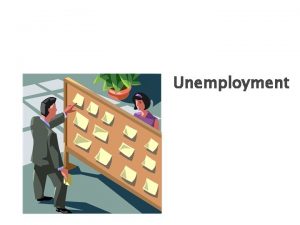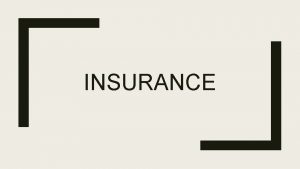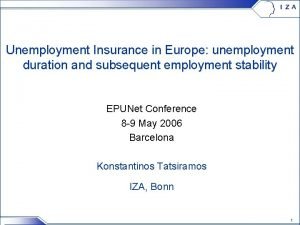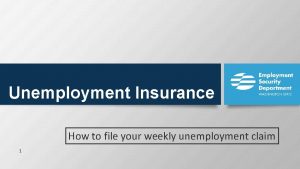UTAH DEPARTMENT OF WORKFORCE SERVICES UNEMPLOYMENT INSURANCE O














































- Slides: 46

UTAH DEPARTMENT OF WORKFORCE SERVICES UNEMPLOYMENT INSURANCE O. A. R. S. Orientation/Assessment Eligibility Review System (Combining the ER and Profiling Processes) by Bill Starks 1

The Old Profiling Model • In 2004, our profiling model was updated using data taken from claimants who had filed in the previous three years: 2001 -2003. • Scott Gibbons from DOL in Washington D. C. helped us pick the most predictive variables. • Variables used in our 2004 Profiling Model included: –Level of Education –Claim filing time lapse –Tenure –Industry –Wage replacement rate –Severance Status –High Quarter Earnings –Month claim was filed • Claimants were excluded if they : –Had a work search deferral –Had not received a first payment –Had a claim duration lower than 15 weeks 2

Under the Old Profiling System • Profiled referrals were limited to each individual Employment Center’s capability to handle referrals. • This amounted to an average of 55 profiled referrals per week. • The referral process was labor intensive. • One-third of an FTE was dedicated to sending referrals to Employment Centers. • Each of Utah’s 38 Employment Centers dedicated from. 5 to 1 FTE to profiled claimants. • Referred claimants were required to go to Employment Centers even though most did not want to go. • These claimants used few services. 3

OARS • In 2006, Utah was awarded a $100, 000 grant to build an internet Eligibility Review system to improve performance by integrating the Eligibility Review and Profiling processes. • This project became known as OARS • The Orientation and Assessment Eligibility Review System. 4

The Eligibility Review • In 2006, Utah upgraded their UI benefits system from a DOS based system called GUIDE to a Windows based system called CUBS. • At the time Utah received the OARS grant, the Eligibility Review information was still being captured in the GUIDE system, and the workers interface was on the Intranet. • OARS enhanced the ER process by moving both the information that was being captured and the workers interface into the CUBS system. • OARS also made the claimant’s web interface more user friendly. 5

The Profiling Model Update • As part of the OARS project in 2008, the profiling model was reevaluated using data from 2006, 2007, and part of 2008. • Twenty eight variables were extracted from our database and sent to Scott Gibbons at the Department of Labor in Washington DC. – Scott ran the variables through his software to identify the most predictive variables. 6

Variables Sent to Scott • • • • Base period wage Benefit year begin date Benefit year end date Claimant party id County of residence Education level Employer party id Exhausted benefits in last three years Expect to be recalled but have no recall date High quarter earnings divided by base period earnings Industry of separating employer (NAICS) Initial claim file date Last employer experience rating Local area unemployment LAUS • • • • Maximum benefit amount Number of base period employers Number of spells in the last three years Occupation with separating employer (ONET) Partial earnings reported Percent of beneficiaries receiving reemployment services Percent of claim exhausted Potential duration Reason for separation Severance pay Tenure with separated employer Time between loss of job and filing of claim Wage loss replacement ratio Weekly benefit amount 7

The Profiling Model • Scott discovered that the variables Utah was using were still the most predictive variables. However, the coefficients attached to those variables were updated. • Variables used in our Profiling Model still include: – Level of Education –Claim filing time lapse – Tenure –Industry – Wage replacement rate –Severance Status – High Quarter Earnings –Month claim was filed • Claimants are not scored if they : – Have a work search deferral – Have not received a first payment 8

The Profiling Model • Because the ER and Profiling process would be linked, certain controls needed to be put in place to manage how many claimants would be referred so ER staff would not become overwhelmed with ERs. • Claimants are given a score based on the variables discussed previously and are placed into a holding pool. • In the holding pool, claimants are evaluated according to their potential duration and divided into deciles according to their profiling score. • Claimants are then placed into groups, and each group is assigned a pick score. • A pick score boundary is set, so no claimants will be referred beyond the pick score boundary. • The department sets the level of referrals that will be generated based on ER workload by increasing or decreasing the pick score boundary (which is currently set at 12). 9

The Pick Scores 10

ER/O&A Selection • The Eligibility Review Supervisor sees the number of claimants who can be referred and enters the number of ERs he wants to order. • If the number he selects is less than the number of profiled claimants eligible to be referred, only profiled individuals will be selected for an eligibility review. • If the number he selects is greater than the number of profiled claimants eligible to be referred, all eligible referrals will be sent out, and the rest of the ERs are randomly selected from the general claimant population. 11

Completing/Not Completing ER/O&A • The OARS project automates the orientation, assessment, and referral process for profiled claimants. • Referred claimants are notified by an auto-generated letter to go online and complete an Eligibility Review, which contains an orientation and assessment, or they must show good cause for failure to comply. • Claimants selected from the random population also receive an autogenerated letter to go online and complete an Eligibility Review. • Claimants who comply have their Eligibility Review evaluated by a UI employee. • Claimants who do not comply have their benefits stopped and receive an auto-generated benefit denial notice with appeal rights. • Note: a phone Eligibility Review option is available for claimants who do not have Internet access. 12

Orientation and Assessment • The content of the orientation and assessment was designed and developed in cooperation with Employment Services staff. • It is designed to inform the claimant about services DWS offers. • It also asks specific questions to help claimants identify their needs. • At the end of the assessment claimants are provided information to access the resources that help fill those needs. 13

Benefits of the New System • Because the number of profiled referrals is managed by the Eligibility Review unit, the number of referrals Utah is able to generate will increase. • Referred individuals receive Eligibility Reviews which can help motivate them to become reemployed. • The referral process is automated. • This saves the 1/3 FTE UI used to generate referrals. • Employment Centers will get only those claimants who want services. • Online resources are provided to help claimants find the information they want. • Claimants are also encouraged to visit Employment Centers for further information. 14

Demographics • People who have the potential for being selected for a profiling referral: – 71% have 12 years of education or more – 56% are younger than 40 – On average the majority of claimants selected have a total of $37, 000 -$40, 000 in their base period 15

OARS Process 16

Have you returned to full-time employment? 17

Claimant enters last three weeks of job contacts 18

Claimant Provides Qualifying Information 19

Claimant Provides Additional Qualifying Information 20

Claimant Provides Additional Qualifying Information 21

Claimant Provides Additional Qualifying Information 22

Claimant Starts Orientation/Assessment 23

Training and Education 24

Job Search, Interviews and Resumes 25

Supportive Services 26 26

Eligibility Review and Orientation/ Assessment are now Complete 27

Claimant is given Links that Correspond to the O&A Answers 28

…Links that Correspond to the O&A Answers Continued… 29

…Links that Correspond to the O&A Answers Continued. 30

? Any Questions 31

Wagner-Peyser ARRA TEGL 14 -08 Upgrading Information Technology Expected Project Outcomes 32

Wagner-Peyser ARRA Funds • Utah received over $4, 000 in funding. • The Recovery Act allows for funds to be spent on information technology upgrades to better target and serve UI Claimants. • We plan to allocate $500, 000 of these funds for authorized information technology upgrades. 33

Categorize UI Claimants For Re-employment Services • At initial claim filing, Claimants will be categorized into five groups, which will indicate the type of re-employment services they need. (see TEGL 14 -08, page 21 -22) 34

Identifying Claimant Groups 35

UI Data Integration With Employment Services • CUBS will populate UWORKS with Claimant category data. • At first pay, Claimant categorization may be adjusted based on profile scores. 36

UI Data Integration Continued • CUBS can populate UWORKS with: • • UI Benefit Year-end Date Interstate Claimant Status Citizenship Alien Registration Number Social Security Number Attending-school Indicator Years of Education Driver’s License Information 37

UI Data Integration Continued • Cubs can populate UWORKS with: • • • Ethnicity Race Base Period Employment History ONET Codes Availability for Full Time work OARS Orientation & Assessment information • UWORKS Work Registration will be expedited. 38

LMI Data Integration With Employment Services • LMI data will be integrated with UWORKS 39

Technology Infrastructure Upgrade • Auto-Coding software will be implemented • ONET Codes of Employer’s job opportunities will be automatically assigned. • ONET Codes of Claimant’s work history will be automatically assigned. • http: //www. onetsocautocoder. com 40

Technology Infrastructure Upgrade - Continued • Claimants will be linked to job openings when they file web initial claims and web weekly claims. 41

Project Benefits • UI claimants will be more effectively guided to reemployment services, which will reduce the time they spend being unemployed. • Shorter periods of unemployment will save money in the UI Trust Fund and will reduce workload for DWS staff. 42

Project Benefits – Continued • DWS staff will have better information available about UI claimants, enabling them to more efficiently provide targeted reemployment services. • Automated reemployment service delivery systems will be enhanced, saving UI Claimant’s time and allowing DWS to provide more service with existing staff. 43

Project Benefits - Continued • Although the targeted population for these technology upgrades is UI Claimants, all DWS Customers will potentially benefit from Auto Coder. • When the special funding through ARRA is exhausted, the improved technology infrastructure will remain, providing service to DWS Customers and efficiencies to DWS staff. 44

Project Benefits - Continued • This project will also have a neutral effect on DWS’ budget, because the project will be fully funded by additional Wagner-Peyser funds. • Integration of labor market information will help DWS staff and all job seekers more effectively focus on re-employment opportunities. 45

Any Questions ? 46
 Utah department of insurance
Utah department of insurance Unemployment insurance act 63 of 2001
Unemployment insurance act 63 of 2001 Utah department of health child care licensing
Utah department of health child care licensing University of utah financial and business services
University of utah financial and business services Elements of fire insurance contract
Elements of fire insurance contract Aba therapy billing and collections
Aba therapy billing and collections Marsh risk & insurance services
Marsh risk & insurance services Ccs insurance services
Ccs insurance services National crop insurance services
National crop insurance services Aba therapy billing software
Aba therapy billing software Energy insurance services
Energy insurance services Networked insurance
Networked insurance Unified products and services packages
Unified products and services packages Meteorological services for insurance
Meteorological services for insurance Iowa department of health and human services
Iowa department of health and human services Worcester electrical inspector
Worcester electrical inspector Washington state department of social and health services
Washington state department of social and health services Juvenile assessment center miami
Juvenile assessment center miami Department of agriculture consumer services
Department of agriculture consumer services Deshaney v winnebago county social services
Deshaney v winnebago county social services Caldwell county dss
Caldwell county dss Albany county department of social services
Albany county department of social services Seattle human services department
Seattle human services department Bidsync miami dade
Bidsync miami dade Icg grant illinois
Icg grant illinois Department of correctional services strategic plan
Department of correctional services strategic plan Virginia department of agriculture and consumer services
Virginia department of agriculture and consumer services California department of general services
California department of general services Department of criminal justice services ny
Department of criminal justice services ny Mussd
Mussd Department of health and senior services missouri
Department of health and senior services missouri Cacfp nebraska
Cacfp nebraska New hampshire department of administrative services
New hampshire department of administrative services Dms state of florida
Dms state of florida Milwaukee county health and human services
Milwaukee county health and human services Maine department of health and human services
Maine department of health and human services Delaware county human services
Delaware county human services The 4 types of unemployment
The 4 types of unemployment Economic unemployment
Economic unemployment Types of unemployment
Types of unemployment Voluntary unemployment
Voluntary unemployment South africa unemployment rate by race
South africa unemployment rate by race Calculate unemployment rate
Calculate unemployment rate Unemployment consequences
Unemployment consequences Types of unemployment
Types of unemployment Objectives of unemployment
Objectives of unemployment Factor of unemployment
Factor of unemployment
